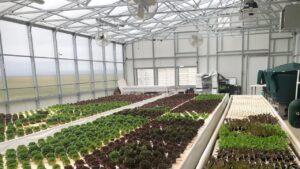 By Dick Hall-Sizemore
By Dick Hall-Sizemore
Greenhouses have been used since the time of the Roman Empire. A couple of Virginia Beach entrepreneurs are planning to use this old technology to harness the sun’s energy in a big way.
Their company, Sunny Farms, plans to invest $60 million to build hydroponic greenhouses on more than 30 acres, about 25 football fields, over three years. It would be one of the largest greenhouse facilities on the East Coast. The goal is to produce fresh vegetables for the big box chain stores in Hampton Roads, as well as for military commissaries. In its first year of operation, the company projects it will grow 10 million plants.
Just as importantly, the operation will create 155 new jobs, with an average annual salary of $51,500. Employees will include horticultural scientists and production specialists.
My Soapbox. Even hydroponic farming is not new. The Department of Corrections started using hydroponic greenhouses many years ago to grow vegetables for use in inmate dining halls. Now, every prison has at least one such greenhouse, and some have several. Typically, they grow lettuce, cucumbers, and tomatoes. I am a lover of fresh tomatoes grown outdoors in dirt and, therefore, was skeptical of the hydroponic tomatoes. I was pleasantly surprised that they were pretty good. The cucumbers are those specially bred for hydroponics. The vines grow up heavy twine that has been erected on frames and the cucumbers themselves are thin and over a foot long.
This operation is obviously not on the scale of Amazon or even Amazon distribution centers, but small businesses are vital for a healthy economy. And, 155 new, good-paying jobs is good news anywhere.
One of the founders of the company is from Pungo, the traditionally agricultural section of Virginia Beach. Each year, on my annual vacation to Sandbridge, I see additional subdivisions where fields used to be. At least, this new project will be continuing the agricultural tradition of that area, just in a different format.

Leave a Reply
You must be logged in to post a comment.